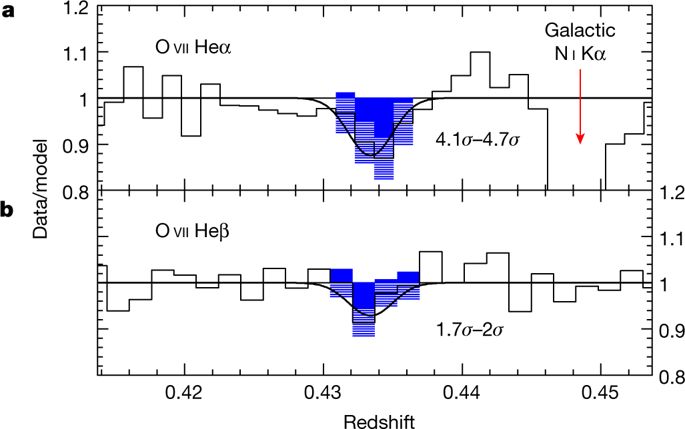Our official English website, www.x-mol.net, welcomes your feedback! (Note: you will need to create a separate account there.)
Observations of the missing baryons in the warm–hot intergalactic medium
Nature ( IF 64.8 ) Pub Date : 2018-06-01 , DOI: 10.1038/s41586-018-0204-1 F. Nicastro , J. Kaastra , Y. Krongold , S. Borgani , E. Branchini , R. Cen , M. Dadina , C. W. Danforth , M. Elvis , F. Fiore , A. Gupta , S. Mathur , D. Mayya , F. Paerels , L. Piro , D. Rosa-Gonzalez , J. Schaye , J. M. Shull , J. Torres-Zafra , N. Wijers , L. Zappacosta
Nature ( IF 64.8 ) Pub Date : 2018-06-01 , DOI: 10.1038/s41586-018-0204-1 F. Nicastro , J. Kaastra , Y. Krongold , S. Borgani , E. Branchini , R. Cen , M. Dadina , C. W. Danforth , M. Elvis , F. Fiore , A. Gupta , S. Mathur , D. Mayya , F. Paerels , L. Piro , D. Rosa-Gonzalez , J. Schaye , J. M. Shull , J. Torres-Zafra , N. Wijers , L. Zappacosta

|
It has been known for decades that the observed number of baryons in the local Universe falls about 30–40 per cent short1,2 of the total number of baryons predicted3 by Big Bang nucleosynthesis, as inferred4,5 from density fluctuations of the cosmic microwave background and seen during the first 2–3 billion years of the Universe in the so-called ‘Lyman α forest’6,7 (a dense series of intervening H i Lyman α absorption lines in the optical spectra of background quasars). A theoretical solution to this paradox locates the missing baryons in the hot and tenuous filamentary gas between galaxies, known as the warm–hot intergalactic medium. However, it is difficult to detect them there because the largest by far constituent of this gas—hydrogen—is mostly ionized and therefore almost invisible in far-ultraviolet spectra with typical signal-to-noise ratios8,9. Indeed, despite large observational efforts, only a few marginal claims of detection have been made so far2,10. Here we report observations of two absorbers of highly ionized oxygen (O vii) in the high-signal-to-noise-ratio X-ray spectrum of a quasar at a redshift higher than 0.4. These absorbers show no variability over a two-year timescale and have no associated cold absorption, making the assumption that they originate from the quasar’s intrinsic outflow or the host galaxy’s interstellar medium implausible. The O vii systems lie in regions characterized by large (four times larger than average11) galaxy overdensities and their number (down to the sensitivity threshold of our data) agrees well with numerical simulation predictions for the long-sought warm–hot intergalactic medium. We conclude that the missing baryons have been found.Observations of two absorbers of highly ionized oxygen in the X-ray spectrum of a quasar account for the missing baryons in the Universe.
中文翻译:

对暖-热星系际介质中缺失重子的观测
几十年来,人们都知道,根据宇宙微波背景的密度波动推断,局部宇宙中观测到的重子数量比大爆炸核合成预测 3 的重子总数少约 30-40%1,2并在宇宙的前 2-30 亿年中在所谓的“莱曼 α 森林”6,7(背景类星体的光谱中一系列密集的介入 Hi Lyman α 吸收线)中看到。这个悖论的一个理论解决方案是将丢失的重子定位在星系之间的热而稀薄的丝状气体中,被称为暖-热星系际介质。然而,在那里很难检测到它们,因为这种气体中迄今为止最大的成分——氢——大部分是电离的,因此在具有典型信噪比的远紫外光谱中几乎看不见8,9。事实上,尽管进行了大量的观察努力,但迄今为止仅提出了少数检测的边缘声明2,10。在这里,我们报告了在红移高于 0.4 的类星体的高信噪比 X 射线光谱中对两个高度电离氧 (O vii) 吸收体的观察结果。这些吸收体在两年的时间尺度上没有变化,也没有相关的冷吸收,因此假设它们来自类星体的内在流出或宿主星系的星际介质是不可信的。O vii 系统位于以大(比平均水平大四倍)星系超密度为特征的区域,它们的数量(低至我们数据的灵敏度阈值)与长期寻找的暖-热星系际介质的数值模拟预测非常吻合。我们得出结论,丢失的重子已经被发现。在类星体的 X 射线光谱中对两个高度电离氧吸收体的观察解释了宇宙中丢失的重子。
更新日期:2018-06-01
中文翻译:

对暖-热星系际介质中缺失重子的观测
几十年来,人们都知道,根据宇宙微波背景的密度波动推断,局部宇宙中观测到的重子数量比大爆炸核合成预测 3 的重子总数少约 30-40%1,2并在宇宙的前 2-30 亿年中在所谓的“莱曼 α 森林”6,7(背景类星体的光谱中一系列密集的介入 Hi Lyman α 吸收线)中看到。这个悖论的一个理论解决方案是将丢失的重子定位在星系之间的热而稀薄的丝状气体中,被称为暖-热星系际介质。然而,在那里很难检测到它们,因为这种气体中迄今为止最大的成分——氢——大部分是电离的,因此在具有典型信噪比的远紫外光谱中几乎看不见8,9。事实上,尽管进行了大量的观察努力,但迄今为止仅提出了少数检测的边缘声明2,10。在这里,我们报告了在红移高于 0.4 的类星体的高信噪比 X 射线光谱中对两个高度电离氧 (O vii) 吸收体的观察结果。这些吸收体在两年的时间尺度上没有变化,也没有相关的冷吸收,因此假设它们来自类星体的内在流出或宿主星系的星际介质是不可信的。O vii 系统位于以大(比平均水平大四倍)星系超密度为特征的区域,它们的数量(低至我们数据的灵敏度阈值)与长期寻找的暖-热星系际介质的数值模拟预测非常吻合。我们得出结论,丢失的重子已经被发现。在类星体的 X 射线光谱中对两个高度电离氧吸收体的观察解释了宇宙中丢失的重子。



























 京公网安备 11010802027423号
京公网安备 11010802027423号